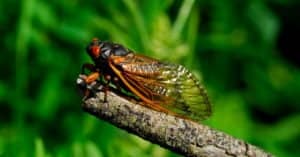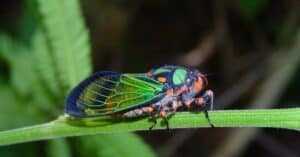With the many changes in the world today, the abrupt boom of cicadas along the eastern region of the United States is understandably concerning. They look much like locusts, which gives them a rather foreboding appearance, even though it is not the same family.
While a locust is much more like a grasshopper, a cicada has a similar look to an aphid. Still, the large numbers of any insect can be worrisome without a little more information. As they show up in parks, neighborhoods, and literally anywhere else, it is best to prepare.
As cicadas come up from underground at the end of their 17-year life cycle, they break out of their shells. During their brief emergence, they will reproduce and make a bunch of noise only die shortly after. While they were living underground, they got sap from trees’ roots. But after emerging they get tree sap from branches and slit tree branches to lay eggs inside. Though most trees can sustain this just fine, the branch-cutting and egg-laying can harm young or unhealthy trees and shrubs. Fine-mesh netting can help protect such plants.
What do the Pest Specialists have to say?
Understanding why these cicadas are emerging in Washington, DC, provides a little insight, based on this tweet from the Pest Specialists. Cicadas come from underground nests during springtime, but the boom that is about to reach Washington, DC, and other areas is like no other. Researchers anticipate that the eastern coast should expect to see trillions of these creatures in the next month or two. The brood is believed to be one of the biggest groups of cicadas to emerge to date.
What does the Washington Post have to say?
This new influx of insects is none other than the Brood X cicadas’ outburst, according to the Washington Post. While there are many incredible events that only occur every few decades, the interactions from commenters on Twitter make it clear that it isn’t quite what they had in mind. Reports of the insects are being posted from commenters everywhere, but there are still more to come.
After all, as Professor Daniel Gruner of the University of Maryland points out, “My opinion is that these emergences are still localized and spotty, in small numbers, and not widespread — at least in what I was able to observe.”
RELATED: Cicadas in Maryland: What’s Happening Now
What does the Entomological Society of America have to say?
The earliest of the cicadas to emerge seem to primarily be in Washington DC, though there are some in Cincinnati as well, according to entomologist Gene Kritsky of the Mount St. Joseph University. However, scientists are looking to find a way to connect where these cicadas are showing up, using a new app called Cicada Safari.
Kritsky’s app has already gotten the attention of 87,000 people, helping the researchers to map out exactly where and when Brood X is emerging. Kritsky remarked, “With smartphone technology and GPS location services, it was just a perfect way to do citizen science.”
WJZ CBS Baltimore Reports a D.C. Area Restaurant Shutting Down over Cicadas
One thing is certain – despite the many cicada sightings, this brood has not even reached its peak, and there are already concerned citizens that are trying to protect themselves. Little Pearl – a Michelin Star restaurant in the Washington DC area – has already shut down temporarily in anticipation of what’s to come.
Cicada Brood X News & Information
Brood X is currently (spring 2021) emerging on the east coast of the United States. More information and coverage can be found here!
- Cicadas in New York: What’s Happening Now?
- Cicadas in Pennsylvania: What’s Happening Now?
- Cicadas in Virginia: What’s Happening Now?
- Cicadas in Tennessee: What’s Happening Now?
- Cicadas in Washington, DC: What’s Happening Now?
- Cicadas in Maryland: What’s Happening Now?
- Here’s What 1.5 Million Cicadas Looks Like
- Will Cicadas Cause More Snakes? Copperheads?
- Can Dogs Eat Cicadas?
- Will Cicadas Eat My Tomato Plants?
Up Next…
- Cicada Brood X 2021: What is it and should you be concerned?: Find out all about the Cicada brood of 2021. What can you expect from this invasion and how to protect yourself.
- Why Do Cicadas Only Come Out Every 17 Years?: What is the secret behind this 17 year cycle of invasion? Find out here.
- Cicadas vs Locusts: What’s The Difference?: Are locusts and cicadas same? Find out here.
The photo featured at the top of this post is © Georgi Baird/Shutterstock.com
Thank you for reading! Have some feedback for us? Contact the AZ Animals editorial team.





